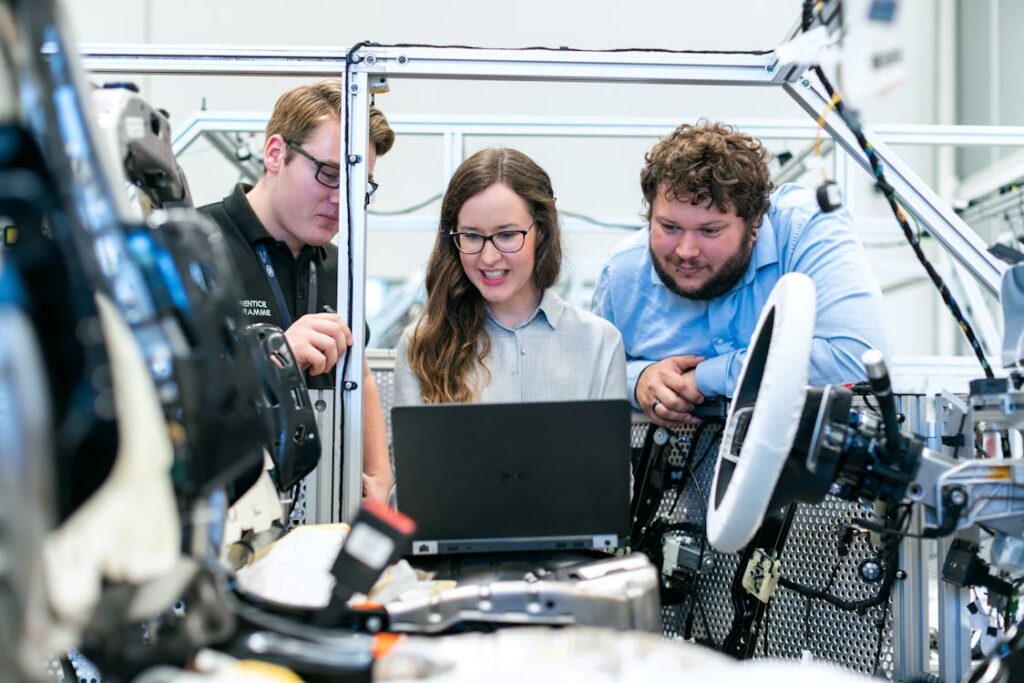Self-driving cars and smart cities showcase human ingenuity and advanced engineering marvels. Behind these innovations are brilliant minds skilled in electrical and computer engineering. These experts create intelligent systems that enable autonomous vehicles and interconnected urban technologies.
They combine software, hardware, and creative problem-solving to build solutions that shape the future. Their work spans artificial intelligence, robotics, telecommunications, and embedded systems.
These individuals are not just technologists, they are pioneers of a new digital revolution. Understanding their roles offers insights into the collaborative nature of modern technological advancements. In this article, we’ll explore the key areas driving these transformative technologies.
AI as The Backbone of Autonomous Vehicles
Artificial intelligence enables self-driving cars to learn, adapt, and respond to real-world challenges efficiently.
In May 2024, IoT Tech News reported that Wayve raised $1.05 billion from investors for their “embodied AI” tech. This funding will advance their embodied AI technology, helping self-driving cars navigate unpredictable real-world situations.
CEO Alex Kendall praised the UK’s AI ecosystem for promoting innovation and supporting Wayve’s rapid development with top talent.

Engineers develop such tech by designing algorithms that process visual data, enabling vehicles to “see” their surroundings. These systems analyze traffic patterns, detect obstacles, and predict movement with incredible accuracy.
Electrical and computer engineers develop machine-learning models for decision-making in real time. Safety protocols embedded into these AI systems minimize risks during unexpected scenarios. Collaboration across AI experts and hardware specialists ensures optimal system performance.
Embedded Systems at the Heart of Smart Technology
Embedded systems serve as the core components powering both vehicles and smart city technologies. These systems are combinations of hardware and software, designed for specific tasks with precision. Electrical engineers design microcontrollers to execute real-time processing for complex operations.
IBM notes that a microcontroller unit is a compact computer on a chip that manages specific tasks. It integrates a processor core, memory, and I/O peripherals for efficient real-time signal processing. MCUs excel in controlling motors, interfacing with sensors, and handling communications in data-driven embedded systems.
In self-driving cars, embedded systems manage braking, acceleration, and navigation simultaneously without failure. Smart cities use these systems to control traffic lights, energy grids, and surveillance devices seamlessly.
Engineers ensure these systems are compact, energy-efficient, and highly reliable under varied conditions. Their development involves meticulous attention to software optimization and hardware integration. This foundational technology connects the digital world effortlessly.
Communication Systems That Keep Everything Connected
Communication systems allow autonomous vehicles and smart cities to share critical information in real-time. Engineers create wireless networks to enable cars to communicate with infrastructure and other vehicles securely.
Vehicle-to-vehicle (V2V) communication ensures collision avoidance by sharing speed, direction, and location data instantly.
V2V is a wireless communication protocol that allows vehicles to share speed, location, and direction data. Vehicles gain a 360-degree view by exchanging information up to 10 times per second. This technology warns drivers about collisions, lane departures, blind spots, and dangerous road conditions, improving overall safety.
Smart cities rely on robust communication channels to coordinate public services and optimize traffic flow. 5G technology plays a vital role in enabling ultra-fast, low-latency data transmission. Electrical and computer engineers design protocols that ensure uninterrupted communication across diverse environments. Maintaining secure and reliable networks is critical for ensuring user trust and system efficiency.
Making Machines Smarter with Robotics and Automation
Robotics and automation are essential for enabling autonomous vehicles to function without human intervention. Engineers design robotic components such as sensors and actuators that translate commands into physical actions effectively.
In smart cities, robotics manage tasks like waste collection and infrastructure monitoring with precision. Automation engineers create workflows allowing these systems to operate continuously with minimal manual oversight. Self-driving cars rely on robotics to execute steering, braking, and acceleration commands accurately.
Engineers continuously refine these systems for durability, responsiveness, and adaptability under real-world conditions. Automation creates streamlined processes that save time and resources by integrating robotics into everyday operations.
The Role of Advanced Degrees in Driving Innovation
Education is essential for preparing engineers to address challenges posed by rapidly advancing technology. Advanced degrees in engineering provide specialized knowledge in artificial intelligence, robotics, and embedded systems development.

These programs teach technical skills while emphasizing critical thinking, problem-solving, and leadership abilities effectively.
Innovations in self-driving cars and smart cities often emerge from research by highly educated individuals. A master’s in electrical and computer engineering program offers impactful training for creating autonomous technological systems.
According to Kettering University, students gain expertise in designing intelligent algorithms and refining communication protocols for seamless functionality. These programs combine theoretical knowledge with practical applications to develop transportation and urban infrastructure solutions. Graduates are uniquely positioned to address complex challenges and lead advancements in these emerging fields.
Indeed mentions that a master’s in computer engineering opens doors to high-paying roles like hardware design engineers, earning $88,712. Network engineers design infrastructure and ensure system security, with an average salary of $79,969 annually. Systems engineers, with a salary of $84,945, oversee complex projects, integrating hardware, software, and operational systems seamlessly.
FAQs
How Is Ai Tested For Real-World Applications?
Testing AI for self-driving cars involves both virtual simulations and physical road tests. Engineers simulate a wide variety of scenarios to observe how AI responds under different conditions. In real-world testing, the vehicle’s performance is assessed for accuracy, safety, and decision-making to ensure reliability in diverse environments.
What Role Does Software Play In Embedded Systems?
Software is integral to embedded systems as it controls the functionality and execution of tasks. It interacts directly with hardware components to ensure the system functions as intended. Engineers write specialized software that optimizes performance, ensuring embedded systems can handle complex operations reliably and efficiently under varying conditions.
What Benefits Does A Master’s Degree Offer To Engineers?
A master’s degree offers engineers a deeper understanding of emerging technologies, enhancing career opportunities. Graduates gain expertise in specialized fields, making them valuable assets for companies developing innovative solutions. With advanced qualifications, engineers are better equipped to lead teams and drive progress in industries like autonomous vehicles and smart cities.
The rise of self-driving cars and smart cities highlights the power of interdisciplinary collaboration. Electrical and computer engineers, with advanced degrees, lead the charge in this technological revolution. They integrate AI, robotics, and communication systems to build intelligent infrastructure transforming urban spaces.
These innovations require deep knowledge, dedication to safety, and a focus on sustainability. As technology advances, engineers’ roles will grow even more essential. Their work not only enhances lives but also shapes more sustainable, equitable societies. The future depends on their expertise to continuously evolve technologies and create smarter cities that benefit everyone.

